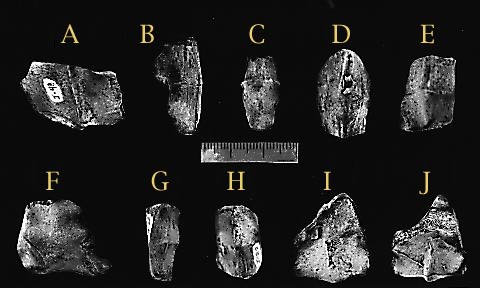Pages 24 - 32
Return to History 8 Environment Bone From a Dry Sea
3. How to find fossils:
Fossils are physical evidence from a time or time period prior to recorded human history. An example is in the book A Bone From a Dry Seaon page 26 "On the table were what looked like flakes of stone arranged in rows on two trays. Most of them were smaller than a penny. Between the trays was a rounded blob of Plasticine, onto which a few flakes had been fitted together." This is an example on how to find fossils because they are using a model to help identify the fossil.
For more information go to: [[1]] or A Bone From a Dry Sea
4. Place changes: tectonics NOT IN CHAPTER RB
5. Archaeology: Other steps in archaeology Archaeology is the study of ancient and recent human past through material remains and example of this is in A Bone From a Dry Sea on page 26 "'Is it someone's skull?' she said 'Correct. A fellow called Homo Habilis, maybe. Maybe not. Looks like we've got about half a cranium, if we can fit it together.'" This is an example of a type of archaeology that is used to help Identify fossils.

Peter Cannon
For More information go to: [[2]] or A Bone From a Dry Sea by Peter Dickinson
Archaeology is the study of past cultures and the way people lived based on material remains. Archaeology consists of more than just discovering and uncovering material remains and is a process that takes many steps. For example, in the book, "A Bone from a Dry Sea", other steps in archaeology is shown after fossil fragments were found and "flakes of stone [were] arranged in rows on two trays...a few flakes had been fitted together to form irregular patches" (26). Even after these archaeologists discovered the fossil fragments, they had to try to put the pieces together. Identifying fossils is another step in the archaeological process besides the discovery of material remains. Without this step, there would be no complete fossil to use as evidence in future studies. Also, it is important to share your finds with the scientific community and the general public so everyone benefits. The sharing of information can be done through magazines, exhibits in museums, web sites, and many more ways. "A Bone from a Dry Sea" portrays the important step of sharing information through the quote, "What he really liked was still fossils...when he died he set up the Craig Museum back in Denver...he put it into his will that it's got to have a paleontology department" (30). In the book, they show the step of sharing information by having a person set up an exhibit in a museum. When scientists share their findings, it helps the whole scientific community to advance further and discover new material remains.

Sources:
Origins Manual page 10
"A Bone from a Dry Sea" by Peter Dickinson page 26 and 30
Photo: Fossil Fragments
-Yukiko Chevray